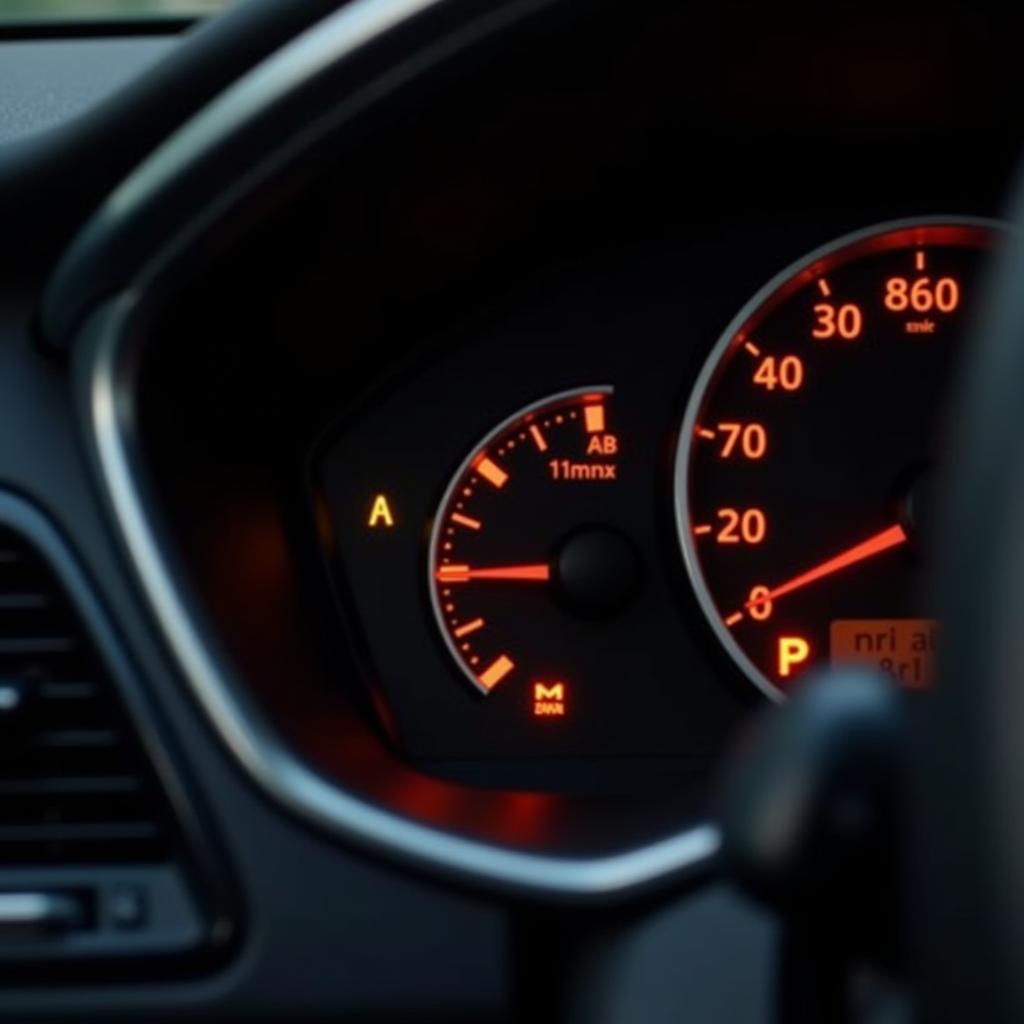Seeing both your ABS and brake warning lights illuminated on your dashboard can be a nerve-wracking experience. This article provides a comprehensive guide to understanding why these lights come on, the potential problems, and how you can address them, sometimes even remotely.
Understanding the ABS and Brake Warning Lights
The Anti-lock Braking System (ABS) light indicates a potential problem within the ABS, a crucial safety feature that prevents wheel lockup during hard braking. The brake warning light, however, signals a more general braking system issue, which could range from low brake fluid to worn brake pads. When both lights illuminate simultaneously, it signifies a more complex issue that requires immediate attention. Don’t delay diagnosis, as ignoring these warning signs can compromise your safety and lead to more extensive and costly repairs.
 ABS and Brake Warning Lights Illuminated on Dashboard
ABS and Brake Warning Lights Illuminated on Dashboard
Common Causes of Both Warning Lights
Several issues can trigger both the ABS and brake warning lights. A common culprit is low brake fluid, which can impact both the conventional braking system and the ABS functionality. A faulty ABS module, responsible for controlling the anti-lock braking system, can also activate both warning lights. Additionally, a malfunctioning brake pressure sensor or a problem within the ABS control unit can lead to this dual illumination.
Diagnosing the Problem
Diagnosing the root cause requires a systematic approach. Begin with checking your brake fluid level. If it’s low, topping it off might resolve the issue. However, persistently low fluid indicates a leak, demanding immediate professional inspection. If the fluid level is adequate, a diagnostic scan using specialized software is necessary to pinpoint the fault codes stored within the vehicle’s computer. This software can reveal specific issues within the ABS module, sensors, or other components.
Remote Diagnostics and Repair
Modern technology allows for remote diagnosis and programming of automotive systems, including ABS and braking systems. This remote access enables experienced technicians to identify and resolve issues without physical access to your vehicle. For instance, software updates or reprogramming of the ABS module can often be performed remotely, saving you time and potentially money. However, more complex mechanical issues, like replacing faulty sensors or brake lines, still require hands-on repair in a workshop.
How Remote Diagnostics Work
Remote diagnostics involves connecting your vehicle’s onboard diagnostics port (OBD-II) to a specialized device that transmits data to a remote server. A skilled technician can then access this data and analyze it to pinpoint the source of the problem. In some cases, they can even perform software updates or reprogramming remotely, effectively resolving the issue. what is avast anti theft can help protect your vehicle’s software from unauthorized access.
Addressing the Warning Lights
Depending on the diagnosed fault, repairs can range from simple fluid top-ups to more complex component replacements. Low brake fluid necessitates identifying and fixing the leak. A faulty ABS module might require replacement or reprogramming. Malfunctioning sensors need replacing to ensure accurate readings and proper system operation.
Conclusion
Addressing both the ABS warning light and brake warning light promptly is critical for your safety. Utilizing remote diagnostics and programming can often provide a quick and efficient solution for software-related issues. However, remember to consult with qualified technicians for any necessary mechanical repairs. Ignoring these warning signs can compromise your braking performance and put you at risk. Don’t hesitate to seek professional help if your ABS and brake warning lights are illuminated.
FAQ
- What is the difference between the ABS light and the brake light? The ABS light signifies a problem within the Anti-lock Braking System, while the brake light indicates a more general braking system issue, such as low fluid or worn pads.
- Can I drive with both lights on? While you might still be able to brake, it’s highly recommended not to drive with both lights on. The safety of your braking system is compromised.
- How much does it cost to fix these warning lights? The cost varies depending on the underlying cause. It can range from a simple fluid top-up to more expensive component replacements.
- Is remote diagnosis reliable? Yes, remote diagnosis is a reliable method for identifying software-related issues and performing necessary updates or reprogramming.
- Can I fix the problem myself? While some minor issues like low brake fluid can be addressed by yourself, it’s always recommended to consult with a qualified technician for accurate diagnosis and repair.
- What if the lights stay on after fixing the issue? If the lights remain illuminated after repairs, further diagnostics are necessary. It could indicate a persistent problem or a new fault.
- How often should I check my brake fluid level? It’s a good practice to check your brake fluid level at least once a month or as recommended in your vehicle’s owner’s manual.


